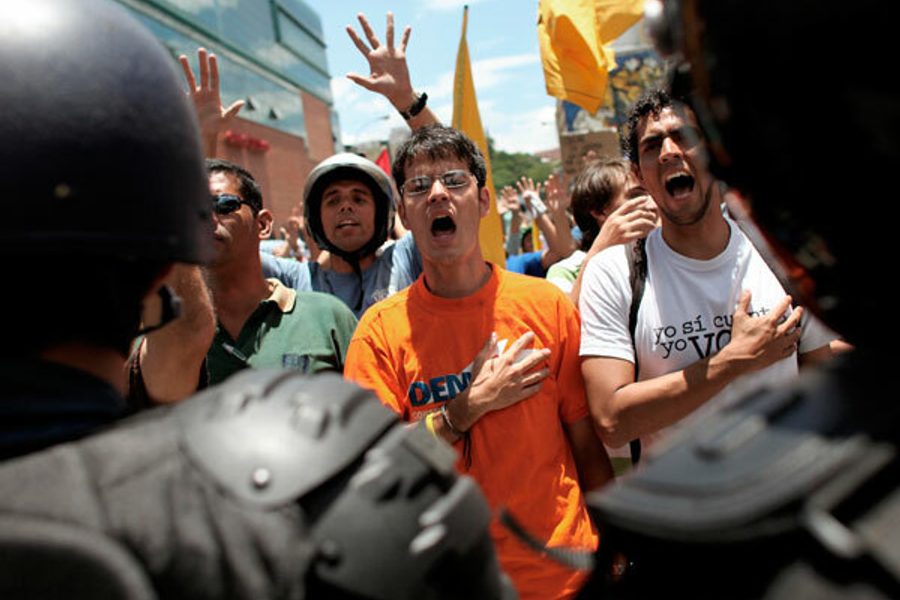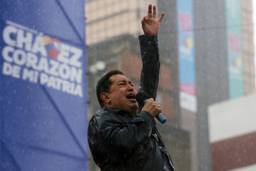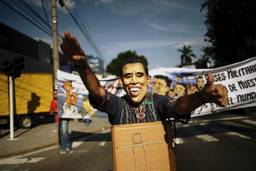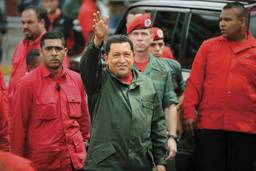Rethinking Venezuelan Politics
Ten years after Chavez’s election, the movement he inspired remains divided over goals and strategies.
Steve Ellner

Hugo Chavez has become the face of Venezuela. But if we are to understand the ongoing debate over strategies for change in Latin America, we must step back from the avalanche of Chavez headlines and examine what is happening on the ground around Latin America’s most visible leader. Indeed, an analysis of concrete developments in Venezuela sheds light on the viability of movements and struggles in developing countries that aim to transform their respective societies and challenge domination from the north.
Throughout the developing world, these types of political contestation have been initiated from “above” and from “below”: by the state and political parties that seek to obtain and retain power, and by social movements and unorganized sectors of the population.
One strategy, traditionally called “anti-imperialist,” leads to the assertion of sovereignty by third-world governments and the formation of a bloc of nations around common demands and goals. With this in mind, the traditional Latin American left promoted “revolutions of national liberation,” whereby a government linked to an institutionalized political party, a powerful labor movement, and sometimes a progressive national business sector, played an interventionist role in the economy and challenged foreign economic interests. Before globalization began in the 1980s, nearly all those who supported far-reaching political change defended a statist (or “top-down”) strategy along these lines.
A second, grassroots approach centers on horizontal relationships that arise outside of established power structures, often in the form of social movements that are internally democratic and more loosely structured than political parties.
The champions of this paradigm have been identified with various related schools of thinking. One of them is the “post-modernist” school, which glorifies popular movements and views broad sectors of the population whose daily lives clash with the logic of the established system as potentially more revolutionary than political parties. These writers rule out forceful government assertion of independence as unfeasible due to global constraints and the danger of international isolation. They also consider statist strategies hierarchical and thus limited in their ability to create meaningful, far-reaching change.
To party or not to party
The difference between the two approaches within the Chavista movement is most easily revealed by the attitudes of its members toward political parties. Those who belong to and closely identify with the main parties of the governing coalition – which includes Chávez’s party, the United Socialist Party of Venezuela (PSUV), as well as the Homeland for All party – tend to defend the statist approach. Chavistas who are independent and critical of the political parties adhere to the grassroots strategy, which spurns vertical political structures. For these “independents,” participation in Chavista social movements or government programs serves as a substitute for party membership and promotes a sense of identification with Chavismo.
The independents stand for a “grassroots” or “horizontal” approach, which favors maximizing the input of rank-and-file Chavistas in decision-making, including the naming of candidates to run for office. They are critical of party leaders for tolerating corruption and promoting bureaucratic behavior that dampens enthusiasm for the movement.
At the Constituent Assembly in 1999, which drafted the nation’s current constitution (subsequently ratified in a national referendum), the grassroots line of thinking underpinned the thesis that direct democracy would eventually displace (rather than complement) representative democracy. Those who identify with the grassroots approach were encouraged when, in April 2001, Chávez harshly criticized party bureaucrats for failing to represent and harness the zeal of the movement’s popular base, and, as a corrective, called for the activation of social and political movements such as the community-based groups known as “Bolivarian Circles.” Beginning in early 2004, Chávez again invoked the “grassroots” vision by calling for a “revolution in the revolution” to shake up bureaucratic structures and unleash an all-out war on corruption.
Party leaders in general favor a “vertical” or statist approach that views the Chavista party as essential to the revolutionary process and calls for the maintenance of the movement’s unity at all costs. The verticalists are wary of the undisciplined and occasionally disruptive behavior of the Chavista rank-and-file. And just like those who champion the grassroots approach, those who support the vertical approach can draw on important aspects of the Chavista experience as well as remarks by Chávez himself.
Can Caracas water the grassroots?
Even though Chávez occasionally criticizes Chavista politicians and the state bureaucracy for being out of touch with the people, he recognizes the Chavista political parties’ outstanding legislative role, beginning with the activity of party representatives in the Constituent Assembly ten years ago.
The ongoing friction between a large number of “independents” who actively support Chávez, on the one hand, and the main governing parties, on the other, is a unique feature of the Chavista process. The failure of both groups and their respective strategies to gain the upper hand during these ten conflict-ridden years of Chavista rule undermines the argument that one of the two approaches is unviable as a strategy for revolutionary change in the modern political setting and should be discarded.
The Chavista model that began to emerge in 2004 stimulated local, community and worker participation in accordance with the grassroots approach. The creation of tens of thousands of cooperatives, the encouragement of worker input in decision making in both private and public companies, and the formation of “Community Councils” (beginning in 2006) to oversee, and in some cases undertake, activity ranging from public works to health programs at the neighborhood level embodied the essence of the new model. Recent efforts to build on the emerging model include a government plan to create links between community councils as well as to stimulate their participation in schools located in their neighborhoods.
These developments, however, have faced major practical obstacles and fall short of the expectations of the grassroots purists who celebrate the absolute autonomy of social movements and distrust the intentions of the central government. But contrary to what the purists advocate, the Venezuelan state has played a central role in giving form to the grassroots approach.
The state has created structures conducive to popular participation, promoted “socialist” values and financed activity that channels the energy of the large number of Chavistas who have a tenuous or non-existent relationship with the main parties of the governing coalition. In the process, the state has been instrumental in enhancing the sense of empowerment of the Chavista movement’s rank-and-file.
Pro-Chavista social organizations and rank-and-file political groups, such as the Bolivarian Circles which proliferated throughout the country at the time of the coup in 2002, have been short-lived. Nevertheless, the continuous creation of new ones demonstrates the tenacity of “grassroots” thinking and behavior. (Chávez has often called for the formation of social organizations, such as the Community Councils, after which they have sprung up throughout the country outside of the confines of Chavista party structures.)
A fine balance
The vulnerability of grassroots structures to interference, particularly from local political figures, was made clear in the case of neighborhood organizations that were designed to deepen decentralization beyond the state and municipal levels.
The politicization of these organizations occurred with the formation of the Local Councils of Public Planning (CLPP). According to legislation passed in 2002, the CLPPs were to choose priority projects for their respective communities. The mayors, however, ended up controlling many of the CLPPs, thus violating the spirit of the legislation. When a law passed in April 2006 basically replaced the CLPPs with Community Councils, Chávez insisted that the new bodies be led by community leaders free of commitments to politicians.
“Grassroots” writers underscore the importance of struggles, slogans and actions that empower the non-privileged and excluded sectors of the population. The activity of community groups and social movements during the Chavez period have enhanced the self-confidence and pride of groups such as women, Afro-Venezuelans and indigenous people. The state has played an important initial role in this process of transformation of consciousness, even though in the long run the new mentality encourages the councils to seek greater autonomy.
In spite of the tension that exists between the two approaches, the programs and proposals associated with each one are to a certain extent complementary rather than contradictory or mutually exclusive. Thus, for instance, those who support the grassroots approach embrace Chávez’s call for the creation of “social controllerships” – consisting of popular ad-hoc committees in the communities and other locations – to monitor public programs and probe cases of alleged misuse of state expenditures.
In contrast, the top-down approach urges the strengthening of institutional mechanisms, such as the National Superintendency of Cooperatives (SUNACOOP) of the Ministry of the Communal Economy, which is in charge of overseeing worker cooperatives.
Although both the controllerships and SUNACOOP can function side by side, the two approaches manifest widely different concerns and values. Those who favor the grassroots approach, for example, complain that institutional obstacles created by SUNACOOP block or slow down the legal registration of new cooperatives due to lethargic, inefficient government bureaucrats.
At the same time, those who adhere to the top-down approach argue that the campaign to promote new “socialist” ways of thinking through the grassroots can hardly be viewed as a panacea for the problem of unethical behavior among the beneficiaries of these programs. They insist that SUNACOOP receive sufficient resources to oversee state-financed cooperatives and that it be invested with authority to clamp down on the misuse of funds.
Rank-and-file rancor
On the political front, a purely grassroots approach proved to be largely out of tune with Venezuelan political reality. During the early years of Chávez’s presidency, the prospects of the grassroots approach appeared promising. Not only did social organizations play a constructive role in formulating proposals which were incorporated in the 1999 constitution, but the pro-Chávez “Bolivarian Circles” prospered shortly after that.
Nevertheless, the Circles and other organizations of the Chavista movement proved short-lived as their members enlisted in the missions, cooperatives and other state-sponsored activities that provided them with personal opportunities. Some writers who defend the “grassroots” approach, such as Michael Hardt, have failed to recognize this hard reality, and claim that the growth of autonomous social movements in the barrios is “the most powerful and novel element in Venezuela’s Bolivarian revolution,” rather than its “anti-imperialist stance.”
During the ten years of the Chávez presidency, the assertiveness and self-identification of rank-and-file Chavistas – those unaffiliated with any political party, who adhere to the grassroots approach – have not diminished in intensity. Their perception of “us” versus “them” with reference to their relations with Chavista party leaders is typical of their ongoing resentment toward hierarchical structures, even those committed to revolutionary change.
Many of these Chavistas dropped out of social groups to join state-financed programs including the community councils. Participation in state-initiated and financed activities is a far cry from membership in autonomous social movements extolled by “grassroots” theoreticians.
Nevertheless, their involvement in the missions is significant from a political viewpoint: It cements identification with Chavismo, just as membership in a Chavista social organization, party or union would have done. In spite of their migration from social organizations to state-sponsored programs, their critical attitudes toward political parties (such as the PSUV) and local government, and their support for the grassroots approach, have remained unaltered.
Re-organizing a revolution
The co-existence of support for both grassroots and statist strategies within the Chavista movement over such a lengthy period of time, and Chávez’s own endorsement of elements of both, suggest the necessity of a synthesis. The logical starting point for achieving such a synthesis is the democratization of the Chavista party to create mechanisms for the rank-and-file to participate in decision-making in accordance with the grassroots approach, while maintaining a centralized command and enforcing internal discipline.
Recent proposals put forward by Chavistas and sometimes endorsed by Chávez in favor of party re-organization are designed to generate formal debate in such arenas as ideological conferences, internal elections and party publications that would open opportunities for different Chavista political currents to formulate positions. (Indeed, internal democratization without ideological clarification leads eventually to vacuous factionalism based on personality differences.)
The coalescence of Chavista parties and social organizations into the PSUV in 2007 (which held internal primaries for the selection of candidates for governor and mayor the following year) provides a golden opportunity to breathe new life into the Chavista party and to deepen democracy. At the same time, however, the PSUV runs the risk of suppressing diversity within the movement in the name of the long-term goal of “twenty-first century socialism,” which still awaits definition.
Indeed, it is the everyday practice of the Chavista government and movement that will determine the outcome of Venezuela’s fledgling model. The transformation still underway in Venezuela is certain to become an important point of reference for political observers and activists throughout the world for years to come. Hopefully the debate it inspires ends up being richer and more productive than the disputes between the various “isms” (Trotskyism, Stalinism, Maoism, etc.) that so fragmented the Left in the past.
This article was adapted from Ellner’s book Rethinking Venezuelan Politics: Class, Conflict, and the Chavez Phenomenon, which has just been re-issued in paperback by Lynee Rienner Publishers. The book can be ordered here.







